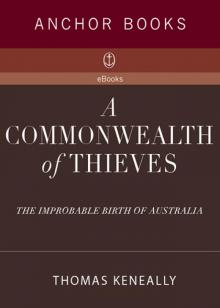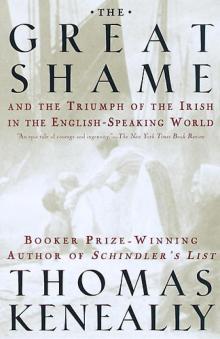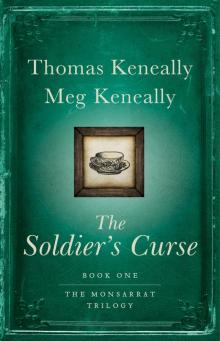- Home
- Thomas Keneally
Australians Page 5
Australians Read online
Page 5
The anchors were brought on board and the forward topmast set up, and she edged in towards the land. While she sailed the crew fothered her—that is, passed a bandage of sailcloth entirely round her keel, and tightened it in place. Cook was delighted with Midshipman Monkhouse for undertaking the operation and fulfilling it so well. Though Banks had feared that the men might in panic and desperation run berserk on the ship, the crew had behaved well.
On 16 June, a time of temperate tropic warmth on this coast, Cook was able to run through a narrow channel into a harbour, intending to careen his ship. As the tide receded, the damage could be looked at. A large hole had been torn in the starboard side, but the coral that had come away from the reef had partly plugged the hole and the fother had then sealed it in place. While the ship lay on the sand, propped up by logs, and while the carpenters went to work on its hull, a hospital tent was set up ashore for Tupaia and Mr Green who were both ill. A diet of fresh fish rapidly but temporarily cured Tupaia and improved Mr Green the astronomer, although neither man would live to see the northern hemisphere, and Cook would blame them for neglecting their vegetables.
The high land here was barren and stony, and the banks of a river, inevitably named the Endeavour, and its backwaters were covered with jungle and mangrove swamp. ‘A very indifferent prospect,’ as Cook said. In Aboriginal mythology the landscape to which Cook was indifferent was the work of a scrub python ancestor named Mungurru. ‘Before that old scrub python travelled down to the sea,’ said an elder, some years later, ‘there was no river there.’ The people with whom Cook made tentative contact were the Guugu Yimidhirr. There was early trouble when some of the Aboriginals lit grass as a way of blocking the passage of the English ashore. ‘In an Instant, the whole place was in flames,’ wrote Cook. There was also argument over ownership of turtles Cook captured. And on 23 June, a previously unsighted animal was seen. It resembled a wild dog but jumped and ran like a hare or deer. The Europeans did not get a good look at one again until 7 July, when on a long walk they saw four of the animals. They outran Banks’s greyhounds, who were caught in the dense grass over which the kangaroos leaped. At least that’s what the Guugu Yimidhirr people told them they called the beast—Gangurru. On 14 July, Lieutenant Gore shot one. ‘To compare it to any European animal would be impossible as it has not the least resemblance to any one I have seen,’ wrote Banks. ‘Its forelegs are extremely short and of no use to it in walking, its hind again are as disproportionately long; with these it hops seven or eight feet at each hop.’ Rather like a gerbil, he thought, except this kangaroo weighed 38 pounds (17 kilos) and a gerbil was no bigger than a rat.
A larrikin story remains about this historic naming: that when Cook asked what the beast was called, an Aboriginal, in replying with the word Gangurru, in effect said, ‘I don’t understand the question.’ But in fact Cook and Banks and Solander got the name right.
The native people remained wary until at last Cook was able to tow the repaired hulk of Endeavour off the beach, rig it and sail north. He found himself in a puzzle of reefs and shoals, afraid that strong seas would cast the Endeavour once more on the coral. ‘A reef such as is here spoke of is scarcely known in Europe, it is a wall of coral rock rising almost perpendicular out of the unfathomable ocean . . . the large waves of the vast ocean meeting with so sudden a resistance make a most terrible surf breaking mountains high.’
At nightfall the Endeavour was only eighty to one hundred metres from the breaking water, ‘only a dismal valley’ the breadth of one wave away from destruction. In its struggle not to be wrecked, it was pushed out through a hole in the reef with the outgoing tide, but the rising tide again pushed it back into danger. Getting away from the interior of the reef and then escaping the outside of it became a recurrent theme. At a narrow point in the reef through which the Endeavour was washed, Cook wrote, ‘It is but a few days ago that I rejoiced at having got without the reef, but that joy was nothing when compared to what I now felt at being safe at an anchor within it, such is the vicissitudes attending this kind of service . . .’
It all became much simpler when the reef broadened out into islands around Cape York. Once the northern promontory was rounded, Cook was fairly confident that he could find a passage into ‘the Indian seas’ and thus home. Cape York was the limit for him—he believed that explorations to the west of it were the business of the Dutch, so just to make the point that he considered his east coast run had turned hinterland British, he once more landed and hoisted the colours and ‘took possession of the whole eastern coast . . . by the name of New South Wales, together with all the bays, harbours, rivers and islands situated upon the said coast, after which we fired three volleys of small arms which were answered by the like number from the ship’. For a ship that was barely 30 metres long, the claim its captain made was prodigious.
There were no quibbles about the rights of the sundry tribes of coastal or inland New South Wales, even when their virtues were considered. ‘From what I have said of the natives of New Holland, they may appear to some to be the most wretched people upon Earth, but in reality they are far more happy than we Europeans; being wholly unacquainted not only with the superfluous but the necessary conveniences so much sought after in Europe, they are happy in not knowing the use of them. They live in a tranquillity which is not disturbed by the inequality of condition: the earth and sea of their own accord furnishes them with all things necessary for life, they covet not magnificent houses, household stuff, etc.’
Some think that this effusiveness of Cook, and its purely philosophic style, is a departure from the normal, commonsensical or navigational tenor of Cook’s journal. Banks had written in like terms: ‘From them appear how small are the real wants of human nature, which we Europeans have increased to an excess which would certainly appear incredible to these people could they be told it.’
On 17 August 1770, the Endeavour turned towards home. By Batavia everyone seemed ill; Tupaia died before Christmas; and the ship needed long repair. Sydney Parkinson, who had done beautiful paintings of specimens taken by Mr Banks, and Dr Spöring, assistant naturalist, both died, as did a corporal of marines, and then Mr Green the astronomer. Banks, too, caught fever, but recovered. The master Robert Molyneaux died in Cape Town.
When England was reached, it was at first a series of accounts written by crewmen on the delicious nature of their contact with Tahitian women which gripped the popular imagination. ‘The women are extremely lascivious,’ wrote a crew member. ‘. . . a virgin is to be purchased here, with the unanimous consent of the parents, for three nails and a knife. I own I was a buyer of such commodities . . .’
It was 29 August 1791 before an officer’s letter was published which gave more substantial news. In the meantime, Banks had the immediate problem of avoiding marriage with Miss Blosset, and he and Solander were introduced twice to the King, had dinner with Boswell and Dr Johnson, another with Benjamin Franklin at the house of the President of the Royal Society, and received honorary doctorates from Oxford. Gradually news of the scope of Cook’s southern hemisphere visitations penetrated the public imagination. But it came to the European mind as a gradual awakening, not in a thunderclap.
It was Banks in particular who had stepped into glory, the discovery of plants and animals counting for more than the charting of the eastern coast of New Holland and its naming as New South Wales. The pre-eminent Swedish botanist Linnaeus wrote that New South Wales should instead be named Banksia. Cook returned to console Mrs Cook, since their four-year-old girl, Elizabeth, had died three months past. The Admiralty eventually acknowledged that their Lordships extremely well approved of the whole of his proceedings, and the several journals and charts he had presented them with. Cook was introduced to the King at St James on 14 August 1771. He was given command of the Scorpion, a sloop, and sent to correct the charts of the English coast. His desire was that he would be sent on another expedition to the South Seas, and that he would command it. He would have his hope.
CHAPTER 3 *
THE ENGLAND COOK RETURNED TO
A remarkable poem by William Blake, the prophet and artist who lived and worked in Broad Street, London, and knew the truth of the city, seems to summarise the age:
I wander thro’ each charter’d street
Near where the charter’d Thames doth flow
And mark in every face I meet
Marks of weakness, marks of woe.
In every cry of every Man
In every infant’s cry of fear,
In every voice, in every ban,
The mind-forg’d manacles I hear.
How the Chimney-sweeper’s cry
Every black’ning church appalls,
And the hapless Soldier’s sigh
Runs in blood down Palace walls.
But most thro’ midnight streets I hear
How the young Harlot’s curse
Blasts the newborn Infant’s tear,
And blights with plague the marriage hearse.
Thus the Britain to which Banks and Cook had brought back news of New South Wales and Botany Bay and the gangurru was one suffering from a range of stresses and rages which it tried to treat by imposing severe penalties on acts of discontent, these ranging from sedition to theft.
The British did not possess the great white spaces of a Siberia to serve as a distant outdoor prison for their criminals, but until the late 1770s they had their American colonies, and had habitually used them. As immortalised in popular ballads, foolish young men and minor criminals, perhaps to the number of 120 000, were torn from the breasts of their lovers to be shipped to ‘Amerikay’. From about 1650 to the outbreak of hostilities between the Americans and British in 1775 they arrived in Virginia or Maryland or the Carolinas, where American settlers would bid for their labour—generally for seven years—at the auction block. The administrative beauty of this was that the master took over the prisoner, and troubled the authorities only in the case of escape or major unruliness. Sometimes vagrants and the poor—‘idle persons lurking in parts of London’—would voluntarily let themselves be transported and sold with the criminals.
London and regional merchants often found this trade in selling the labour of white servants cheaper to engage in than that in African slaves. Based on auction prices in Baltimore between 1767 and 1775, a convict’s labour for his total sentence cost between £10 and £25. It was possible for an affluent convict to bid for himself and do his time as, effectively, a free agent. But very few transported convicts could afford to buy their own labour, or return home from Virginia, Maryland or Georgia, even if they survived the ‘seasoning period’, the first few years of malaria and other diseases which killed two out of five inhabitants of Virginia. The convict engaged in field labour was likely to find an early grave in American soil and never bother the British domestic authorities again.
But in embracing the benefits of transportation for the home nation, the British government sought to solve a domestic issue and barely thought of the impact it had on the colony that received the felons. During the eighteenth century, one North American colonist was left to complain, ‘America has been made the very common sewer and dung yard to Britain.’ But not once the shots rang out at Concord Bridge, and the Minutemen marched on Boston, signalling the commencement of the American Revolutionary War.
A new Transportation Act of 1780, passed during Britain’s very loss of the American colonies, sought to make transportation more obligatory. The reality was that prisoners sentenced to transportation were doing their time not in British colonies but in chaotic, overcrowded prisons while the government waited for the American rebellion to end. The offences for which an individual Briton could be transported under the accumulated Transportation Acts made up an exotic catalogue. Notorious thieves and takers of spoil in the borderlands of Northumberland and Cumberland, commonly called ‘moss-troopers’ or ‘reivers’, were subject to penalties of transportation; similarly, persons found guilty of stealing cloth from the rack, or embezzling His Majesty’s stores to the value of twenty shillings; persons convicted of wilfully burning ricks of corn, hay, etc or barns etc in the night time (a common crime both in England and Ireland and generally associated with peasant protest against landlords); persons convicted of larceny and other offences; persons imprisoned for smuggling wool to France and the Low Countries and not paying the excise on it (a regular Surrey crime); persons convicted of entering into any park and killing or wounding any deer without the consent of the owner; persons convicted of perjury and forgery; persons convicted of assaulting others with offensive weapons with the design to rob; vagrants or vagabonds escaping from a house of correction or from service in the army or navy; persons convicted of stealing any linen laid to be printed or bleached; ministers of the Episcopal Church of Scotland, suspected of support for Bonnie Prince Charlie, exercising their functions in Scotland without having registered their letter of orders, taken all oaths, and prayed for His Majesty and the Royal Family by name; persons returning from transportation without license; persons convicted of entering mines with intent to steal; persons convicted of assaulting any magistrate or officer engaged in the salvage of ships or goods from wrecks; persons convicted of stealing fish in any water within a park, paddock, orchard or yard. Besides legislation imposing the penalty of transportation, between 1660 and 1819 almost two hundred capital, mandatory death sentence statutes were passed, along similar principles, to add to the nearly fifty already in existence.
One sees in the long list a heavy emphasis on the sanctity of two institutions: property, and the Crown under the Royal House of Hanover. The Irish and certain Scots were resistant to the Crown; and as for property matters, William Blackstone, author of Blackstone’s Commentaries on the Laws of England, thought with his friends Dr Johnson and Oliver Goldsmith that ‘theft should not be punished with death’, but Parliament went on churning out statutes which did just that. The lack of a British police force meant that legislators felt they needed to impress the people with the terror of the law.
In theory, frequent public executions should have cut down on crowding in gaols. But even the lawmakers, members of the Commons, might mercifully take up the special cause of this or that prisoner. In a given courtroom, at the bi-yearly Assizes or during the Quarter Sessions, a jury might deliberately undervalue the goods stolen to prevent a prisoner being ‘stretched’. Their gratuitous compassion speaks to us still in the court records’ description of a prisoner as ‘too young’ for the full force of the law to operate, or else as ‘a poor unfortunate girl’ or ‘an unfortunate girl of good family’. But if they didn’t like a prisoner, juries could just as easily indulge feelings of gratuitous outrage.
King George III also attended to reprieves, sitting in council at St James Palace, and receiving advice and lists of prisoners from judges and recorders. He was severe above all on counterfeiters who presumed to forge his head on coins, otherwise generally accepting the recommendation of mercy from the trial judge, as did the Prince Regent, the future George IV, during his father’s illness and lunacy. In the 1770s and 1780s, the royal mercy, flowing across London from St James to Newgate, and out to the county jails of the provinces, helped keep the prisons crammed with transportees who lacked a destination.
As for the individual prisoner, often young, they were aware that when they came in front of the courts, neither judge nor jury would enquire too closely into whether a confession had been beaten out of them. Generally, they appeared without legal counsel. The magistrates they faced at the Quarter Sessions believed one crime unpunished begot another, and questions about the accused’s level of want or disadvantage did not delay them for a second. Nor did the idea the accused was innocent till proved guilty influence them. The prisoner had to prove the ‘prosecutor’—that is, the victim—had made a mistake in identifying them or was acting from malice. Attorneys were slowly becoming employed both as prosecutors and counsel for the defence, but on magistrates’ sufferance.
The trial proceeded more briskly than in modern times—the Georgian version of a day in court was less than a quarter of an hour. Ordinary trials at an Assizes rarely went beyond an adjournment. Major cases all ended with acquittal, transportation or the death penalty—what Londoners called the ‘hearty choke with caper sauce’, ‘nothing more than a wry face and a watered patch of breeches’, and ‘dancing the Paddington frisk’. Yet capital punishment still took forms other than hanging. Women counterfeiters were subject to death by burning, and the heads of Jacobites (Scottish supporters of Bonnie Prince Charlie) were stuck and exposed on spikes at Temple Bar. About one in eight of those committed for trial was sentenced to death, but (based on figures concentrated between 1761 and 1765), fewer than half of those so sentenced were executed.
For many decades there had been eight hanging days at Tyburn Hill every year, a frightful public but ceremonious spectacle. But from the mid 1780s executions occurred outside Newgate prison itself. There, on a spring day in 1785, James Boswell, the Scottish attorney and writer, watched nineteen criminals, including thieves, a forger, a stamp counterfeiter and others who had illegally returned from transportation, ‘depart Newgate to the other world’, and then went on to dinner.
CAMPBELL’S HULKS
An Act of Parliament passed in 1783 allowed the removal of convicts from the overcrowded gaols on land to the dismasted hulks of old men-of-war moored in the Thames, and at Portsmouth and Plymouth, where they could serve their time labouring on harbour works pending transportation. The British government was thus temporarily restricted to transporting its fallen souls not across the Atlantic but a few miles ashore by rowboat. The hulks, an eyesore detested by respectable London, condemned by progressives as academies of criminality, and unpopular with convicts, were both a phenomenon and an enterprise. Duncan Campbell, a reputable man and a good Presbyterian Scot, was the hulk-master. He had begun in the convict-transporting business in 1758, carrying felons to Virginia and Maryland. The revolution in America threw the affairs of Campbell and others into disarray. The amounts lost by British creditors in America, when Americans refused to pay British merchants’ bills, were of a high order, and Campbell had a dizzying fortune of over £38 000 owing to him from gentlemen in Virginia and Maryland. But in modest ways the war in America now compensated him, since he ran the hulks as an enterprise. His initial contract, worth £3560 a year, was for a dismasted hulk (he named it Justitia) of at least 240 tons (245 tonnes) to house 120 prisoners, with necessary tools and six lighters for the convicts to work from, as well as medicines and vinegar as a scurvy cure, and means to wash and fumigate the vessel. By 1780 he had accommodation for 510 convicts, and had purchased a French frigate, the Censor, and an old ‘Indiaman’ which he named Justitia II. He also set up a receiving hulk and a hospital ship.

 Confederates
Confederates Flying Hero Class
Flying Hero Class Gossip From the Forest
Gossip From the Forest Schindler's List
Schindler's List Bring Larks and Heroes
Bring Larks and Heroes Australians: Flappers to Vietnam
Australians: Flappers to Vietnam The People's Train
The People's Train Crimes of the Father
Crimes of the Father A Family Madness
A Family Madness A Commonwealth of Thieves
A Commonwealth of Thieves Ned Kelly and the City of Bees
Ned Kelly and the City of Bees A River Town
A River Town Bettany's Book
Bettany's Book Blood Red, Sister Rose: A Novel of the Maid of Orleans
Blood Red, Sister Rose: A Novel of the Maid of Orleans Victim of the Aurora
Victim of the Aurora American Scoundrel American Scoundrel American Scoundrel
American Scoundrel American Scoundrel American Scoundrel Three Cheers for the Paraclete
Three Cheers for the Paraclete Australians: Origins to Eureka: 1
Australians: Origins to Eureka: 1 The Power Game
The Power Game The Chant Of Jimmie Blacksmith
The Chant Of Jimmie Blacksmith The Daughters of Mars
The Daughters of Mars Searching for Schindler
Searching for Schindler The Great Shame: And the Triumph of the Irish in the English-Speaking World
The Great Shame: And the Triumph of the Irish in the English-Speaking World Abraham Lincoln
Abraham Lincoln The Widow and Her Hero
The Widow and Her Hero Eureka to the Diggers
Eureka to the Diggers Shame and the Captives
Shame and the Captives The Survivor
The Survivor Jacko: The Great Intruder
Jacko: The Great Intruder The Book of Science and Antiquities
The Book of Science and Antiquities Homebush Boy
Homebush Boy The Playmaker
The Playmaker To Asmara: A Novel of Africa
To Asmara: A Novel of Africa A Woman of the Inner Sea
A Woman of the Inner Sea The Tyrant's Novel
The Tyrant's Novel Australians
Australians Schindler's Ark
Schindler's Ark The Soldier's Curse
The Soldier's Curse Australians, Volume 3
Australians, Volume 3 Blood Red, Sister Rose
Blood Red, Sister Rose A Victim of the Aurora
A Victim of the Aurora The Unmourned
The Unmourned Australians, Volume 2
Australians, Volume 2 To Asmara
To Asmara